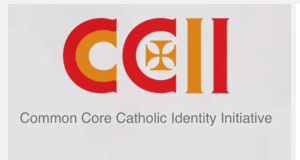Happy Sunday, anti CCSS Warriors! Today’s “Riddle Me This” topic is one an avid reader of my blog asked me to look into. This mom is an active person in her child’s school. Her child was reading their faith formation guide when they stumbled across the words ‘rigourous’, ‘rigor’, and ‘assessments’. As she stated, ‘all clues’ to what she hoped wouldn’t be true. That CCSS had been inserted.
She sent me the link where I was able to get the screen shot you see above. Be sure to enlarge the shot. In the event you aren’t able to, I’ll share below what is so vital to see.
The emblem you see belongs to the National Catholic Educational Association (http://www.ncea.org/my-interests) “NCEA is the largest private professional education organization in the world.”
The NCEA:
“NCEA guides Catholic schools on the path to educational excellence through ongoing initiatives such as the Common Core Catholic Identity Initiative (CCCII), and the New Directions Initiative. Our research efforts consistently highlight the strengths and benefits of Catholic education and emphasize the importance of strong Catholic identity.” NCEA also offers professional development for teachers in the Catholic schools.
Below is the NCEA’s promotional video. Watch careful and you’ll see the Pearson Publishing booth at an NCEA Convention.
[youtube https://www.youtube.com/watch?v=z9VncCEhpao&w=560&h=315]
Here’s the screen shot of the NCEA Partners. The website address to see the entire list is included.

Here’s an excerpt from their position paper on Common Core, “Catholic schools have a long-standing commitment to academic excellence that is rooted in the faith based mission of Catholic education. The Common Core State Standards in no way compromise the Catholic identity or educational program of a Catholic school. The Common Core State Standards initiative, begun in 2007, is a state-led, bipartisan effort that is not a requirement for participation in the No Child Left Behind Act of 2001 (NCLB) or any other federallyfunded program, and there are no mandates for any Catholic school to follow any federal rules if they adopt the Common Core. Adoption of the Common Core is voluntary; individual states, Catholic dioceses and other private schools make their own decisions about whether to adopt the standards. The Common Core State Standards are a set of high-quality academic expectations that all students should master by the end of each grade level. The standards establish consistent learning goals for all students that focus on preparing them to succeed in college and careers in a globally competitive workplace. The standards define and clearly communicate grade-specific goals and inform parents about learning outcomes, making it easier for parents to collaborate with teachers in helping their children achieve success.” If you’d like to read the entire position paper, http://www.ncea.org/sites/default/files/documents/ncea_commoncorestatestandards_053113.pdf
The CCCII (http://cici-online.org/):
As stated above, CCCII stands for ‘Common Core Catholic Identity Initiative’. *NOTE: As part of the NCEA’s accountability aspect, assessments that are standardized, both state and nationally, are used. All kinds of data is collected for use not only for NCEA, but federally, too. Among the data, students who are considered Title One. As we know, the re-authorization of ESEA (the current Student Success Act, HR5) would greatly impact any school receiving Title One funding. To access the data page on the NCEA website, http://www.ncea.org/data-information/catholic-school-data I found their statement concerning HR5 on their ‘public policy’ page. See: http://www.ncea.org/data-information/public-policy
So what does the CCCII look like? Here’s the promo video:
[youtube https://www.youtube.com/watch?v=Ujcy4MLKUe0&w=560&h=315]
Did you hear that?! Wow, if you are like my reader who asked me to look into this, I hope you will respond with truth about CCSS to the NCEA!
From the ‘white paper’ about CCCII’s success with CCSS, ” The Reality of Implementing the Standards: As part of the conference, one diocese explained its experience with the Common Core outlining the process from curriculum alignment and professional development to the assessment and results based on the Common Core Standards. The journey was three years in the making.
In year one, emphasis was placed on instructional shifts, preserving Catholic identity, and building the capacity of instructional leaders and the understanding of teachers. This included professional development for principals and teachers through various modalities. The other component for its first year was the creation of English-Language Arts and Mathematics unit plans. In year two, instructional specialists were engaged to provide a multitude of resources and to help capture the work of the Common Core Catholic Identity Initiative. The two challenges were getting teachers to shift from using the textbook as a curriculum to using the textbook as a resource and aligning four Mathematics textbooks as a resource to the unit plans and standards.
In its third year, there was a new form of assessment that used different types of questions to assess student academic progress. In preparing for the new assessments, interim assessments that were aligned to the Common Core were implemented, as well as an increase in the instructional time for Mathematics. Based on its experience, it was recognized that the Common Core challenges included:
• deconstructing the standards
• reviewing all materials for Catholic appropriateness
• funding and time for quality professional development
• differentiating professional development for schools and teachers that are now at different places along the transition continuum
• meaningful use of the assessment results to improve teaching and learning.” To read the entire 4 page report, http://cici-online.org/resources/articles-research/130-common-core-and-diocesan-catholic-school-leadership-white-paper
Related resources:
The ELA Rubric: cici-unit-review-rubric-form-rev-08-20-2014 When you access this document, read the fine print at the bottom of the page. “EngageNY” is the CCSS laden NY state level board of education.
A Summative Assessment “Mini Lesson”: http://cici-online.org/images/Resources/Section-1-Mini-Lessons/CCCII-Mini-Lesson-Assessment.pdfThe letter to settle a CCCII disturbance: http://www.ncea.org/sites/default/files/documents/cccii_superintendent_letter_15oct13.pdf
A pep talk about implementing the Standards so your Catholic school can be a Blue Ribbon School (U.S. Dept. of Ed ‘honor’): http://www.ncea.org/department-news/implementing-your-strategic-plan
The precursor to today’s article was last Saturday’s expose about CAPE, of which NCEA is a member of: https://www.commoncorediva.com/2015/04/18/sic-em-saturday-grab-a-cape-ccss-warriors/
One last thing:
That New Directions Initiative mentioned above in the paragraph describing NCEA? Oh, that’s all about blended learning! Here’s just one of the workshops NCEA has on it: http://www.ncea.org/events/2015-ncea-new-directions-blended-learning-symposium


Excellent article! Thank you so much for exposing it! I’ll definitely share this with my friends.
>
You are SO welcome!
and here is information on the people behind NCEA
http://www.pghcatholicsagainstcommoncore.com/resource-documents
You are so correct about the NCEA and it’s entanglements with Common Core. Pittsburgh Catholics Against Common Core exposed a lot of this information about the NCEA a few years ago. In fact the CCCII was changed to Catholic Identity Curriculum Integration after the NCEA took heat for curriculum that was in staunch opposition to Catholic teachings. See PCACC webpage for more information on this. Specifically look at the press releases, statement to Bishop Zubik. http://www.pghcatholicsagainstcommoncore.com/must-read-information